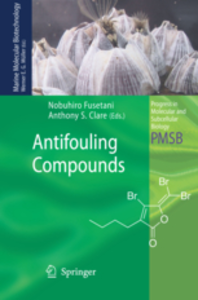Furanones
de Nys, R., Givskov, M., Kumar, N., Kjelleberg, S., and Steinberg, P.D. (2006) Furanones. In: Fusetani, Nobuhiro, and Clare, Anthony S., (eds.) Antifouling Compounds. Progress in Molecular and Subcellular Biology . Springer, Heidelberg, Germany, pp. 55-86.
|
PDF (Published Version)
Restricted to Repository staff only |
||
![[img]](https://researchonline.jcu.edu.au/3627/2.hassmallThumbnailVersion/3627_de_Nys_2006_Book_Cover.jpg)
|
Image (JPEG) (Book Cover)
- Cover Image
Download (64kB) |
Abstract
The red alga Delisea pulchra has been a model organism for understanding the ecological role of secondary metabolites as natural antifoulants. Furanones are produced by the plant and delivered to the surface at a concentration where they regulate bacterial colonisation and the settlement of epibiota. This biological understanding has led to the application of furanones as inhibitors of bac:terial- and macro-fouling. Furanones inhibit bacterial colonisation and biofilm development through interference with a key bacterial quorum-sensing pathway, the acylated homoserine lactone regulatory system in Gram-negative bacteria. They also interfere with the alternative AI-2 signalling system in Gram-negative and Gram-positive bacteria. Synthetic programs have developed a library of more than 200 furanone and furanone-analogues including surface attached-furanones. These furanone analogues are potent anti-infectives and inhibit pathogenic phenotypes in Gram-negative and Gram-positive bacteria as demonstrated in-vitro using gene microarrays, and in-vivo using mouse models. Additionally, furanones inhibit the expression of bacterial exo-enzymes that actively degrade components of the immune system thereby enhancing the immune response. Surface-attached furanones immobilised on catheters also inhibit bacterial attachment and retain activity for extended periods. Furanones are strong deterrents of the settlement and growth of macro fouling organisms and as such have potential application as a marine antifouling technology. Laboratory antifouling assays have been used to identify effective and safe furanone-analogues while field trials of furanones incorporated into coatings and polymers demonstrate efficacies similar to commercial biocides. Further development is required to control the release of compounds from suitable carriers to extend coating/polymer lifespans. This review summarises the extensive work on furanones focusing on their natural and applied antifouling activities.
| Item ID: | 3627 |
|---|---|
| Item Type: | Book Chapter (Research - B1) |
| ISBN: | 978-3-540-30014-4 |
| Keywords: | furanones; delisea pulchra; biofouling; marine ecology |
| Date Deposited: | 08 Dec 2009 03:04 |
| FoR Codes: | 10 TECHNOLOGY > 1099 Other Technology > 109999 Technology not elsewhere classified @ 100% |
| SEO Codes: | 86 MANUFACTURING > 8608 Human Pharmaceutical Products > 860899 Human Pharmaceutical Products not elsewhere classified @ 100% |
| Downloads: |
Total: 140 Last 12 Months: 4 |
| More Statistics |




